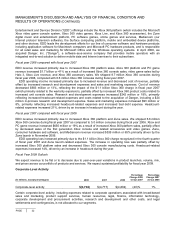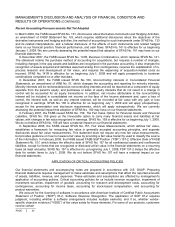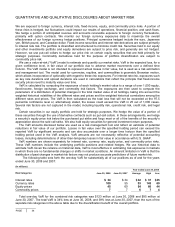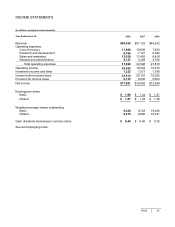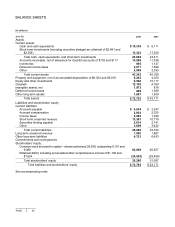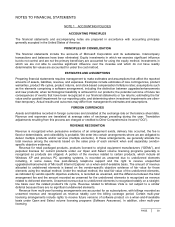Microsoft 2008 Annual Report Download - page 30
Download and view the complete annual report
Please find page 30 of the 2008 Microsoft annual report below. You can navigate through the pages in the report by either clicking on the pages listed below, or by using the keyword search tool below to find specific information within the annual report.
PAGE 29
Contractual Obligations
The following table summarizes our outstanding contractual obligations as of June 30, 2008:
(In millions)
Payments due by period
Fiscal Years 2009 2010-2012 2013-2015
2016 and
thereafter Total
Long-term debt $ – $ – $–
$ – $ –
Construction commitments(1)(2) 1,226 – – – 1,226
Lease obligations:
Capital leases – 1 – – 1
Operating leases(3) 440 831 522 415 2,208
Purchase commitments(2) 2,520 5 – – 2,525
Other long-term liabilities(4) 196 105 – – 301
Total contractual obligations(5) $4,382 $942 $522 $ 415 $6,261
(1) We have certain commitments for the construction of buildings. We expect to fund these commitments with
existing cash and cash flows from operations.
(2) The amounts presented as purchase and construction commitments include all known open purchase
orders and all known contracts that are take-or-pay contracts. We expect to fund these commitments with
existing cash and cash flows from operations.
(3) Our future minimum rental commitments under noncancellable leases comprise the majority of the operating
lease obligations presented above. We expect to fund these commitments with existing cash and cash flows
from operations.
(4) We have excluded long-term tax contingencies and other tax liabilities of $3.8 billion and other long-term
contingent liabilities of approximately $500 million (related to the antitrust and unfair competition class action
lawsuits) from the amounts presented as the amounts that will be settled in cash are not known. We have
also excluded non-cash items of $77 million and unearned revenue of $1.9 billion.
(5) We have excluded $3.1 billion of current taxes payable from the amounts presented. This amount was paid
to the IRS during the first quarter of fiscal year 2009 as a result of our settlement related to the 2000-2003
examination.
RECENTLY ISSUED ACCOUNTING STANDARDS
Recently Adopted Accounting Pronouncements
On July 1, 2007, we adopted FIN 48 which provides a financial statement recognition threshold and measurement
attribute for a tax position taken or expected to be taken in a tax return. Under FIN 48, we may recognize the tax
benefit from an uncertain tax position only if it is more likely than not that the tax position will be sustained on
examination by the taxing authorities, based on the technical merits of the position. The tax benefits recognized in
the financial statements from such a position should be measured based on the largest benefit that has a greater
than 50% likelihood of being realized upon ultimate settlement. FIN 48 also provides guidance on derecognition of
income tax assets and liabilities, classification of current and deferred income tax assets and liabilities, accounting
for interest and penalties associated with tax positions, and income tax disclosures. Upon adoption, we
recognized a $395 million charge to our beginning retained deficit as a cumulative effect of a change in
accounting principle. See Note 11 – Income Taxes of the Notes to Financial Statements.
On July 1, 2007, we adopted Emerging Issues Task Force Issue No. 06-2 (“EITF 06-2”), Accounting for
Sabbatical Leave and Other Similar Benefits Pursuant to FASB Statement No. 43. EITF 06-2 requires companies
to accrue the costs of compensated absences under a sabbatical or similar benefit arrangement over the requisite
service period. Upon adoption, we recognized a $17 million charge to our beginning retained deficit as a
cumulative effect of a change in accounting principle.





